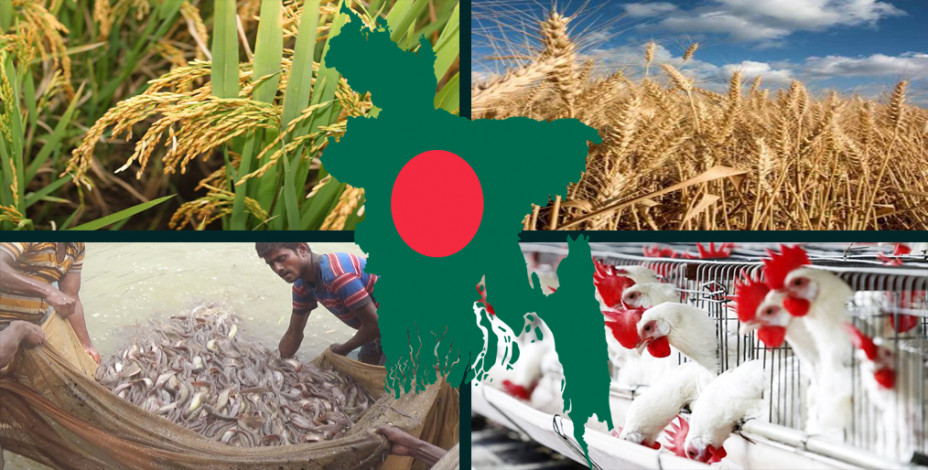
SZ.Kabir: During the first five months (July-November) of the current fiscal year 2019-20, the financial banks distributed Tk. 8 thousand 305 Crore 13 lac. Which is one-third of the total target of the financial year, or a percentage of 34.43. During the same period of the financial year 2018-19, the total agricultural credit was distributed at Tk. 7 thousand 475 Crore 60 Lac. As a result, the distribution of agricultural credit to all public and private banks has increased this year. This information was found in the Bangladesh Bank Update Report. Bangladesh Bank has set a target of providing Tk. 24 thousand 124 Crore in agriculture and rural areas in the current financial year. According to the target, the state-owned commercial and specialized banks will distribute Tk. 10 thousand 375 Crore and private and foreign commercial banks will distribute Tk. 13 thousand 749 Crore. So far, the state-owned commercial banks have distributed Tk. 4 thousand 46 Crore 32 Lac in loans out of Tk. 8 thousand 305 Crore. And domestic and foreign private commercial banks distributed Tk. 4 thousand 258 Crore 81 Lac. Several issues have been added to the new policy. These include reducing agricultural lending through own branch and agent banking to reduce MFI dependency. Loans can be provided for cashew nuts and rambutan cultivation, potato cultivation, goat, sheep, cows rearing, cattle fattening, commercial silk production in the double bed system of kachuripana. Of the loan disbursed, the crop yields Tk. 4 thousand 485 Crore 24 Lac, Irrigation and irrigation equipment Tk. 43 Crore 68 lac; 1, 251 crore 80 lac Tk. on agricultural farm; 48 Crore 6 lac for harvesting and marketing of crops; an amount of Tk. 687 Crore 69 Lac has been distributed in the program for eliminating poverty and Tk. 1 thousand 57 Crore for other agricultural related activities. Concerned banks are being forced to distribute loans every year by setting targets for agricultural loans. The main reason for this is the reluctance of banks on agricultural loans. Besides, the interest rate on agriculture loans is lower than in other sectors. On the other hand, Farmers Bank turned away for fear of harassment and litigation. But under the directive of the central bank, the distribution of debt increased at the end of the financial year. Senior officials of the public-private bank said that while the distribution of credit in agriculture was low at the beginning of the year, the amount continued to increase towards the end. Because banks, at the end of the financial year, strengthen the distribution and collection of loans in order to improve the health of the status sheet and reduce scarcity. As a result, both the distribution and collection of agricultural credit increased. Meanwhile, many organizations are emphasizing the distribution of agricultural credit. The banks which reduce the distribution of agricultural loans, the money is deducted from the bank account of Bangladesh Bank as a penalty. The next year, the money that was deducted was redistributed when the money was redistributed. According to a data from the Bangladesh Bank, when the distribution of agricultural credit was made compulsory at 2 percent in the financial year 2009-10, the amount of distribution of agricultural credit was few more than Tk. 9 thousand Crore in that year. In 10 years, it increased by about 150 percent to reach Tk. 21 thousand 8 Crore. But at the end of the year, the loan disbursed in agriculture is Tk. 23 thousand 616 Crore 25 Lac, which is 8 percent above the target. According to the information of Bangladesh Bank, 2 percent of the total disbursed loan of each commercial bank is to be distributed among the farmers. Agricultural credit is also covered under various programs to alleviate poverty in rural areas. According to the data, it is compulsory to distribute agricultural loans in proportion to other loans. Commercial banks whose do not have branches in rural areas will also have to distribute agricultural loans at a fixed rate through NGO linkages. In this case, the interest rate is determined by the rate at which the interest rate is determined by the microcredit regulatory authority (MRA). In line with the government's food security program, Bangladesh Bank started this program on the 2010. Source: Online
Comment Now